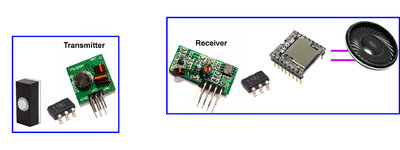barefoot
Newbie

My first post so appologies if I've broken any obvious rules 
I am building a wirless doorbell and was hoping to use the Attiny10 to generate a simple code and send it wireless using a single bit transmitter. Then I'll receive the single bit to another Attiny10 where the simple code is decoded and then activate the door bell by taking an IO pin low.
I doubt I'll find a library (like the manchester encoder) to work on the attiny10. I imagine bit shifting an 8 bit number (as the code) out via an IO with a short delay between each shift. That would work for the transmitter. But I am struggling with the receiver end. I imagine the receiver being asleep and will wake on interrupt from the receiver. And then start shifting in bits with the same delay as the transmitter. If the numbers match and then ring the door bell.
Any thoughts would be much appreciated.
I am building a wirless doorbell and was hoping to use the Attiny10 to generate a simple code and send it wireless using a single bit transmitter. Then I'll receive the single bit to another Attiny10 where the simple code is decoded and then activate the door bell by taking an IO pin low.
I doubt I'll find a library (like the manchester encoder) to work on the attiny10. I imagine bit shifting an 8 bit number (as the code) out via an IO with a short delay between each shift. That would work for the transmitter. But I am struggling with the receiver end. I imagine the receiver being asleep and will wake on interrupt from the receiver. And then start shifting in bits with the same delay as the transmitter. If the numbers match and then ring the door bell.
Any thoughts would be much appreciated.

